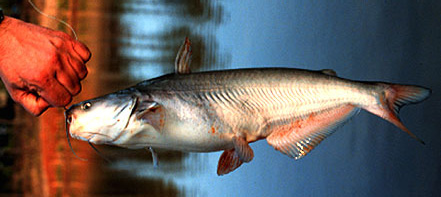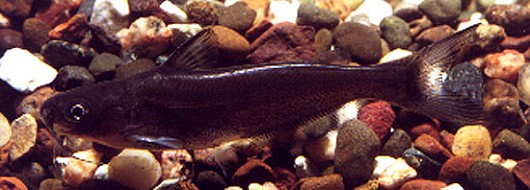Blue Catfish
-
Scientific NameIctalurus furcatus
-
NativeNo
-
Identification
 Blue catfish, adult. Caught in Marion, Alabama on 9 February 1994. Photo by Konrad Schmidt, Nongame Fish Biologist, Division of Ecological Services, Minnesota Department of Natural Resources.
Blue catfish, adult. Caught in Marion, Alabama on 9 February 1994. Photo by Konrad Schmidt, Nongame Fish Biologist, Division of Ecological Services, Minnesota Department of Natural Resources. Blue catfish, young-of-the-year. Photo by Konrad Schmidt, Nongame Fish Biologist, Division of Ecological Services, Minnesota Department of Natural Resources.
Blue catfish, young-of-the-year. Photo by Konrad Schmidt, Nongame Fish Biologist, Division of Ecological Services, Minnesota Department of Natural Resources.- Elongate body with projecting snout
- Deeply forked tail with pointed lobes
- Terminal mouth with white barbels
- Maxillary barbels are just larger than the head
- Pale blue to olive on the sides and white on the belly
- Steeply humped before the dorsal fin
- 30-35 rays in anal fin making a straight edge tapering downwards to the end of the caudal peduncle
- Males also have a urogenital papilla extending towards the tail leaving one opening behind the vent compared to the females’ two openings
-
Life History
Blue Catfish are traditionally found in deep channels of big rivers but can also be seen in large reservoirs and fish farm ponds. Stream dwelling catfish will spend their days on the bottom of moderate flow areas 8-10 m deep before moving into rapids and other swifter waters at night. In reservoirs they stay to the deep sections during the day and feed in the shallow regions at night. They can survive in temperatures from 0°C to 37°C and in salinities as high as 22 ppt but their growth peaks at 27°C and between 7 and 8 ppt. When they are very young, Blue Catfish eat mostly crustaceans and insects but when they are only 10 cm long they will begin feeding on fish and by the time they are 20-30 cm long fish make up the majority of their diet. In early summer, when water temperatures have exceeded 21-25°C, Blue Catfish will move towards the muddy bottomed pools and backwaters of their range to spawn. While their reproductive strategies have not been well studied in California it is known that Blue Catfish require cave-like sites for their nests and it is assumed that the males protect these sites before mating and after birth until their offspring are large enough to survive on their own. Within a year Blue Catfish are an average length of 22-26 cm long and can grow to incredible sizes as they get older. It is not uncommon for a Blue Catfish to grow to be larger than 1.6 m and weigh over 45 kg (Carlander 1969).
-
Links to Other ResearchN / A

